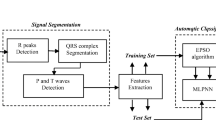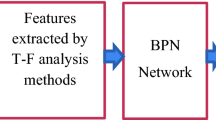Abstract
An approach based on the consideration that electrocardiogram (ECG) signals are chaotic signals was presented for automated diagnosis of electrocardiographic changes. This consideration was tested successfully using the nonlinear dynamics tools, like the computation of Lyapunov exponents. Multilayer perceptron neural network (MLPNN) architectures were formulated and used as basis for detection of variabilities of ECG signals. Four types of ECG beats (normal beat, congestive heart failure beat, ventricular tachyarrhythmia beat, atrial fibrillation beat) obtained from the Physiobank database were classified. The computed Lyapunov exponents of the ECG signals were used as inputs of the MLPNNs trained with backpropagation, delta-bar-delta, extended delta-bar-delta, quick propagation, and Levenberg–Marquardt algorithms. The performances of the MLPNN classifiers were evaluated in terms of classification accuracies. The results confirmed that the MLPNN trained with the Levenberg–Marquardt algorithm has potential in detecting the variabilities of the ECG signals (total classification accuracy was 95.00%).




Similar content being viewed by others
References
Saxena SC, Kumar V, Hamde ST (2002) Feature extraction from ECG signals using wavelet transforms for disease diagnostics. Int J Syst Sci 33(13):1073–1085. doi:10.1080/00207720210167159
Foo SY, Stuart G, Harvey B, Meyer-Baese A (2002) Neural network-based EKG pattern recognition. Eng Appl Artif Intell 15:253–260. doi:10.1016/S0952-1976(02)00041-6
Maglaveras N, Stamkopoulos T, Diamantaras K, Pappas C, Strintzis M (1998) ECG pattern recognition and classification using non-linear transformations and neural networks: a review. Int J Med Inform 52:191–208. doi:10.1016/S1386-5056(98)00138-5
Sternickel K (2002) Automatic pattern recognition in ECG time series. Comput Methods Programs Biomed 68:109–115. doi:10.1016/S0169-2607(01)00168-7
Kundu M, Nasipuri M, Basu DK (2000) Knowledge-based ECG interpretation: a critical review. Pattern Recognit 33:351–373. doi:10.1016/S0031-3203(99)00065-5
Übeyli ED (2007) Implementing wavelet transform/mixture of experts network for analysis of ECG beats. Expert Syst 25(2):150–162
Owis MI, Abou-Zied AH, Youssef A-BM, Kadah YM (2002) Study of features based on nonlinear dynamical modeling in ECG arrhytmia detection and classification. IEEE Trans Biomed Eng 49(7):733–736. doi:10.1109/TBME.2002.1010858
Casaleggio A, Braiotta S (1997) Estimation of Lyapunov exponents of ECG time series—the influence of parameters. Chaos Solitons Fractals 8(10):1591–1599. doi:10.1016/S0960-0779(97)00040-4
Silipo R, Deco G, Vergassola R, Bartsch H (1998) Dynamics extraction in multivariate biomedical time series. Biol Cybern 79:15–27. doi:10.1007/s004220050454
Govindan RB, Narayanan K, Gopinathan MS (1998) On the evidence of deterministic chaos in ECG: surrogate and predictability analysis. Chaos 8(2):495–502. doi:10.1063/1.166330
Fell J, Mann K, Röschke J, Gopinathan MS (2000) Nonlinear analysis of continuous ECG during sleep II. Dynamical measures. Biol Cybern 82:485–491. doi:10.1007/s004220050601
Goldberger AL, Amaral LAN, Glass L, Hausdorff JM, Ivanov PCh, Mark RG, Mietus JE, Moody GB, Peng CK, Stanley HE (2000). Physiobank, physiotoolkit, and physionet: components of a new research resource for complex physiologic signals. Circulation 101(23): e215–e220 (Circulation Electronic Pages; http://circ.ahajournals.org/cgi/content/full/101/23/e215. Accessed 13 June 2000)
Haykin S, Li XB (1995) Detection of signals in chaos. Proc IEEE 83(1):95–122. doi:10.1109/5.362751
Casdagli M (1989) Nonlinear prediction of chaotic time series. Physica D 35(3):335–356. doi:10.1016/0167-2789(89)90074-2
Eckmann J-P, Kamphorst SO, Ruelle D, Ciliberto S (1986) Liapunov exponents from time series. Phys Rev A 34(6):4971–4979. doi:10.1103/PhysRevA.34.4971
Abarbanel HDI, Brown R, Kennel MB (1991) Lyapunov exponents in chaotic systems: their importance and their evaluation using observed data. Int J Mod Phys B 5(9):1347–1375. doi:10.1142/S021797929100064X
Abarbanel HDI, Brown R, Sidorowich JJ, Tsimring LS (1993) The analysis of observed chaotic data in physical systems. Rev Mod Phys 65(4):1331–1392. doi:10.1103/RevModPhys.65.1331
Benettin G, Galgani L, Giorgilli A, Strelcyn J-M (1980) Lyapunov characteristic exponents for smooth dynamical systems and for Hamiltonian systems: a method for computing all of them. Meccanica 15(1):9–30. doi:10.1007/BF02128236
Packard NH, Crutchfield JP, Farmer JD, Shaw RS (1980) Geometry from a time series. Phys Rev Lett 45(9):712–716. doi:10.1103/PhysRevLett.45.712
Wolf A, Swift JB, Swinney HL, Vastano JA (1985) Determining Lyapunov exponents from a time series. Physica D 16(3):285–317. doi:10.1016/0167-2789(85)90011-9
Sano M, Sawada Y (1985) Measurement of the Lyapunov spectrum from a chaotic time series. Phys Rev Lett 55(10):1082–1085. doi:10.1103/PhysRevLett.55.1082
Haykin S (1994) Neural networks: a comprehensive foundation. Macmillan, New York
Basheer IA, Hajmeer M (2000) Artificial neural networks: fundamentals, computing, design, and application. J Microbiol Methods 43:3–31. doi:10.1016/S0167-7012(00)00201-3
Chaudhuri BB, Bhattacharya U (2000) Efficient training and improved performance of multilayer perceptron in pattern classification. Neurocomputing 34:11–27. doi:10.1016/S0925-2312(00)00305-2
Rumelhart DE, Hinton GE, Williams RJ (1986) Learning representations by back-propagating errors. Nature 323:533–536. doi:10.1038/323533a0
Jacobs RA (1988) Increased rate of convergence through learning rate adaptation. Neural Netw 1:295–307. doi:10.1016/0893-6080(88)90003-2
Minai AA, Williams RD (1990). Back-propagation heuristics: a study of the extended delta-bar-delta algorithm. Proceedings of International Joint Conference on Neural Networks 1, 595–600, San Diego, California, 17–21 June 1990
Fahlman SE (1988) An empirical study of learning speed in backpropagation networks. Computer Science Technical Report, CMU-CS-88-162, Carnegie Mellon University, Pittsburgh
Hagan MT, Menhaj MB (1994) Training feedforward networks with the Marquardt algorithm. IEEE Trans Neural Netw 5(6):989–993. doi:10.1109/72.329697
Battiti R (1992) First- and second-order methods for learning: between steepest descent and Newton’s method. Neural Comput 4:141–166. doi:10.1162/neco.1992.4.2.141
Chan L-W (1990). Efficacy of different learning algorithms of the back propagation network. IEEE Region 10 Conference on Computer and Communication Systems, 1, 23–27, Hong Kong, 24–27 Sept 1990
Sidani A, Sidani T (1994). A comprehensive study of the backpropagation algorithm and modifications. IEEE Conference Record, 80–84, Orlando, FL, USA, 29–31 March 1994
Hannan JM, Bishop JM (1997). A comparison of fast training algorithms over two real problems. IEE Fifth International Conference on Artificial Neural Networks, Conference Publication No. 440, 1–6, Cambridge UK, 7–9 July 1997
de Chazal P, Heneghan C, Sheridan E, Reilly R, O’Malley M (2003) Automated processing of the single-lead electrocardiogram for the detection of obstructive sleep apnoea. IEEE Trans Biomed Eng 50(6):686–696
Übeyli ED (2008) Usage of eigenvector methods in implementation of automated diagnostic systems for ECG beats. Digit Signal Process 18(1):33–48
Osowski S, Hoai LT, Markiewicz T (2004) Support vector machine-based expert system for reliable heartbeat recognition. IEEE Trans Biomed Eng 51(4):582–589. doi:10.1109/TBME.2004.824138
Acir N (2005) Classification of ECG beats by using a fast least square support vector machines with a dynamic programming feature selection algorithm. Neural Comput Appl 14(4):299–309. doi:10.1007/s00521-005-0466-z
Author information
Authors and Affiliations
Corresponding author
Rights and permissions
About this article
Cite this article
Übeyli, E.D. Detecting variabilities of ECG signals by Lyapunov exponents. Neural Comput & Applic 18, 653–662 (2009). https://doi.org/10.1007/s00521-008-0229-8
Received:
Accepted:
Published:
Issue Date:
DOI: https://doi.org/10.1007/s00521-008-0229-8




